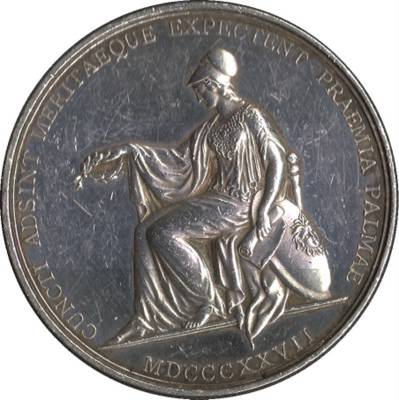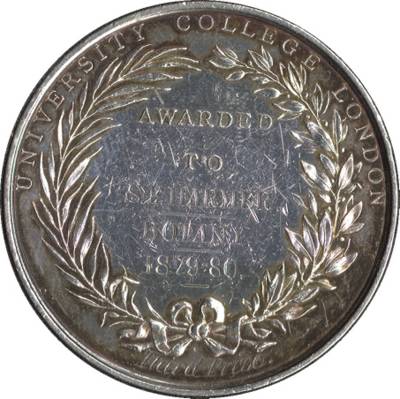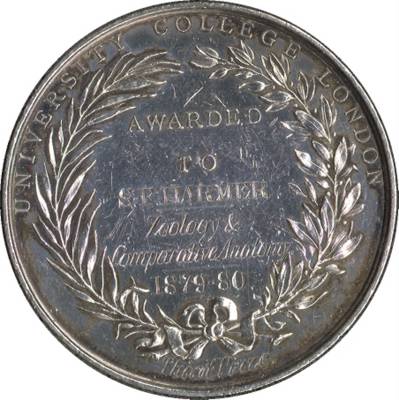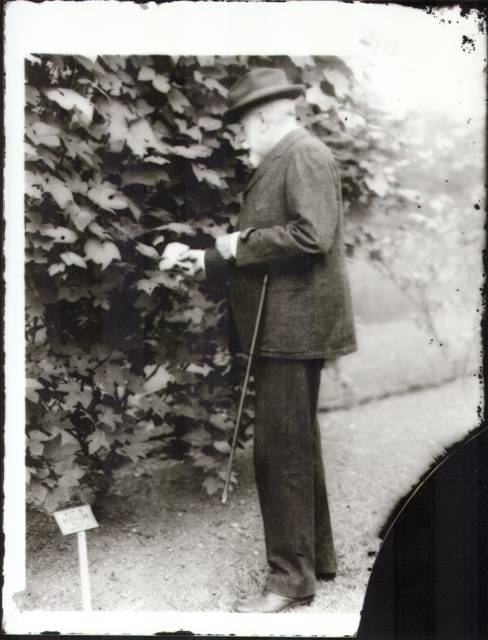Dedicated to information and material related to the history of botany particularly in the 19th and 20th century English speaking world. If you have contributions of interest to post, please contact me at the email address on the left of this page.
Tuesday, August 24, 2004
Number 7 - Name That Botanist
Click HERE for the ID on the verso of this Gustavus W. Pach photograph.
Sunday, August 15, 2004
Sir Sidney Frederic Harmer
He is included on Historica Botanica because of his achievement in botany as an undergraduate at University College, London. He attended that university on a mathematical scholarship. He obtained his B.Sc. in 1881. While there, he came under the influence of Ray Lankester in zoology and F.W. Oliver in botany.
Harmer was certainly a promising student as witnessed by the two medals which appear below. He took the third prize silver medals in both Botany and Zoology/Comparative Anatomy for 1879-1880. These medals both have the identical obverse (only one of which is shown) with the Roman date of 1877.
A lengthy memoriam to Harmer with a listing of his publications appears in the Obituary Notices of Fellows of The Royal Society for 1950-1951 (Volume VII, page 359-371)

Obverse
click on image to enlarge

Botany
click on image to enlarge

Harmer Zoology/Comparative Anatomy
click on image to enlarge
Tuesday, August 10, 2004
Number 6 - Name That Botanist
Click HERE for the ID on the matte of this Ernest Edwards photograph.
Sunday, August 08, 2004
Antoine-Laurent de Jussieu

Jussieu to Molinos
This is a letter from the 18th century French botanist Antoine-Laurent de Jussieu in his post French Revolutionary position at the Jardin des Plantes/Museum Nationalle d'Histoire Naturelle in Paris, to Jacques Molinos, the architect of the museum.
The Jussieu family were an important dynasty of botanists from the mid-18th to the mid-19th century. They were largely responsible for introducing the Natural System of plant classification which improved upon the Artificial (Sexual) System of Linnaeus. The text of the letter and a translation reads as follows:
Au Citoyen Molinos, architecte du museum
Je vous adresse, citoyen, copie de la lettre que je viens de recevoir du Ministre des finances en qui est le résultat de la conférence que nous avons eue hier avec lui. Il consent à recevoir en payement des acquisitions a l’enchère du Palais royal les ordonnances de nos entrepreneurs s'ils se vendent adjudicataires. Vous verrez par la lettre comment leur créance (credit?) peut ou doit constaté ----- en état de les servir sans compromettre ni vous ni moi.
Salut et fraternité,
Jussieu"
To citizen Molinos architect of the museum
Citizen, I am sending you a copy of the letter I just received from the Minister of Finances containing the results of the conference that we had
Health and Fraternity,
Jussieu"
Some biographical notes about A-L de Jussieu (1748-1836):
- Father of Adrien-Laurent-Henri de Jussieu (1797-1853) Cours élémentaire de botanique (1842–44).
- Nephew of Bernard de Jussieu.
- A-L obtained an M.D. degree in 1770 and was brought to Paris by Bernard. He became affiliated with the Jardin du Roi, and managed to keep his head during the Revolution, emerging as Director (1800) and Professor of botany at the renamed Museum National d'Histoire Naturelle (which included the Jardin Des Plantes). In 1773 he presented a paper to the Académie des Sciences on the crowfoot family (Ranunculaceae). This was followed by his most important publication, Genera Plantarum Secundum Ordines Naturales Disposita..... of 1789 which brought forth the Natural System. He resigned from the Museum in 1826.
The French Revolutionary calendar (Jacobin calendar) is used in the dateline of this letter. 26 Ventose an 7 corresponds to March 16, 1799. The letterhead, which is still used by the museum (see upper left of this page) is rich with symbolism. The beehive represents the industrious working class. The Phrygian cap was worn by rebelling slaves in Roman times, and French streetwives during the 1789 revolution. It became one of the Montagnards' symbols of liberty. Sheaves of wheat represent Nature's approval of France's situation (therefore providing abundantly). Grapes had been planted by the Romans, and hence might be a tribute to republicanism.
The recipient of this letter, Jacques Molinos (1743-1831), was appointed architect to the Museum in 1794. His work on the dome over the Halle au Blé was admired by Jefferson.
The letter indicates a confidential tone. It is written by Jussieu in the wake of the sale by auction of the personal property of the Duc d'Orleans. The Duc had been guillotined and the government had chosen to auction off the contents of his ancestral home, the Palais Royal. Jussieu informs Molinos that the Minister of Finances would accept government "funny money" as payment for purchases, so long as it was properly "adjudicated".
Thursday, August 05, 2004
Amos Eaton as Teacher and Promoter of Botany
But these were developments of the 1820s. A much neglected fact in need of emphasis is that Eaton's pivotal role in botanical education had already begun in the years 1815-1820. This was a time of transition in American botany.
Prior to 1815, Philadelphia had been the center of botanical study. It was there that the American Philosophical Society and (by 1812) the Academy of Natural Sciences were located, and it was home to the prestigious University of Pennsylvania and its medical school. The Bartrams and Bartons, Nuttall, Pursh, Baldwin, Muhlenberg, and Darlington were all drawn to Philadelphia and its environs.
It is true that during the first decade and a half of the 19th century there was a smattering of activity in New York (David Hosack, Samuel Mitchill), Charleston (Shecut, Stephen Elliott), Lexington, Kentucky (Rafinesque), and Boston (Bigelow). However, it would not to be until the mid-1820s that New York was to unseat Philadelphia as the center for scholarly botanical activity, and fully another decade before Boston would supplant New York. During the transition years from approximately 1815 to 1825 Amos Eaton looms large as one of the key figures in American science.
Following completion of his Yale studies with Silliman and Ives in early 1817, Eaton moved to Western Massachusetts to accept a teaching position in mineralogy and botany at Williams College. Upon completion of those duties in September 1817, he published the first edition of the Manual of Botany. Armed with favorable endorsements, he began a peripatetic life, giving series of successful botanical lectures in neighboring villages. He had enthusiastic audiences at Northampton, Belchertown, Worcester, Monson, and Brimfield in the short interval between September 1817 and April 1818. He then settled in the Albany-Troy area of New York but continued the life of a nomadic lecturer in New York, Massachusetts, and Vermont for several more years.
Lest one conclude that the attendees of these talks, which were aimed at the general populace, did not also make their mark, it is important to note that several Deerfield, Massachusetts citizens who had listened to Eaton in 1817 must be added (along with John Torrey) to the list of prize students who had early on been inspired by Eaton:
Rev. Edward Hitchcock (future Amherst College President and Professor of Chemistry and Natural History), Dr. Stephen West Williams and Dr. Dennis Cooley all began to collect plants, and arrange herbaria after hearing Eaton (well before his ascendancy at RPI).
Dr. Cooley's botanical pursuits continued lifelong, and in 1849 he published a Flora of Lake Superior (Catalogue of Plants Collected by W.A. Burt on the Primitive Region South of Lake Superior in 1846; in Message from the President of the United States to the Two Houses of Congress at the Commencement of the First session of the Thirty-First Congress, Pt.iii; Washington, 1849).
His herbarium was donated in 1863 to the Michigan Agricultural College (now Michigan State University). He will be the topic of a future posting here on Historica Botanica.
Yet other notable early (pre-Rennselaer School) botanical students of Eaton were:
- Dr. Zina Pitcher (1797-1872), an army surgeon who practiced medicine in Detroit after 1836 following his military career in Michigan, Virginia, and Arkansas. He was elected President of the American Medical Association in 1856, edited the Peninsular Medical Journal (1855-1858), served as President of the Michigan State Medical Society (1855-1856) and authored 41 medical papers. Together with Henry Rowe Schoolcraft and General Lewis Cass, he founded the Michigan Historical Society in 1828. His large herbarium, acquired in 1880 by Isaac C. Martindale, was purchased in 1964 by the USDA for the National Arboretum. His botanical activities are memorialized in several species including "Pitcher's Hog Peanut" (Amphicarpaea bracteata var. comosa), "Pitcher's Thistle" (Cirsium pitcheri) and "Pitcher's Sandwort" (Arenaria patula).
- Dr. Edwin James (1797-1861), who was naturalist and surgeon on Stephen Long's expedition to the Rocky Mountains. He attended lectures by Eaton in Albany and Troy.
For further information:
- Botanical Beachcombers and Explorers: Pioneers of the 19th Century In the Upper Great Lakes by Edward G. Voss; Contributions from the University of Michigan Herbarium; Volume 13, 1978
- Some American Medical Botanists Commemorated In Our Botanical Nomenclature by Howard A. Kelly, M.D.; The Southworth Company, 1914.
Wednesday, August 04, 2004
Number 5 - Name That Botanist

WHO IS THIS BOTANIST?
Click HERE for the ID.

